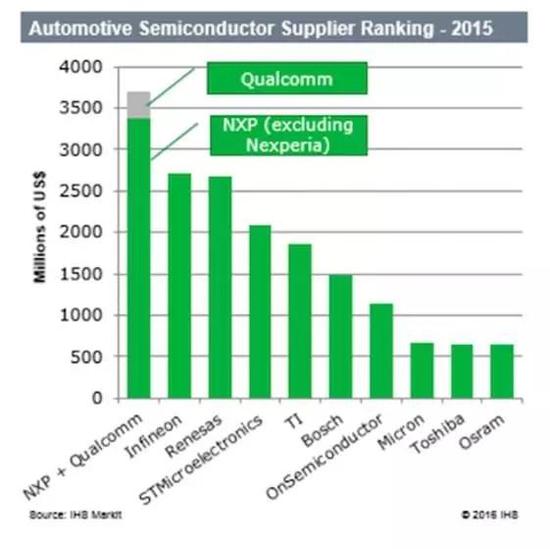After Qualcomm merged with NXP Semiconductors, it will become an IC industry giant with annual revenue of $35 billion and the world's largest supplier of automotive chips, and between Qualcomm and Intel. The competition will also be upgraded. This time, the battlefield between the two companies is a fast-moving new world of highly automated vehicles. Although Intel is not the top ten automotive semiconductor supplier, the semiconductor giant has been gearing up in recent months to prepare for the highly anticipated era of autonomous driving.
Intel's vice president and general manager Ken Caviasca said in an interview that the company's technology "arsenal" covers FPGA to computer vision software, hardware accelerators, artificial intelligence: "We (more than Qualcomm / NXP) have more space to The automotive market expands. "These services include In-vehicle compuTIng, connecTIvity and cloud solutions. In short, Intel is focusing on providing end-to-end solutions for the automotive industry.
Qualcomm's strategy is to acquire tickets to enter the market through the acquisition of NXP, the world's largest automotive chip supplier. Intel's path is more gradual; Intel has acquired a number of smaller companies with diverse technologies, but those technologies It is considered essential for future connected/highly automated vehicles.
In fact, Intel is not a newcomer to the automotive industry, but the automotive business has not been the company's core business; in the mid-1980s, Intel has worked closely with car manufacturers and first-line automotive component suppliers. At the time, Intel's microcontroller (MCU) was very strong. It had a joint venture with Ford in the 1980s to build an electronic control unit (ECU). Intel's 8051 microcontroller and derivative products were said to have been used in almost all Ford from 1983 to 1999. On the car, today, Intel is making a comeback in the automotive field.
Intel chip targets become the brain of unmanned vehicles

In the driverless arena, Intel has formed a three-party business alliance with BMW and Mobileye. Many industry analysts have said that they don't understand this alliance because Mobileye itself is a provider of autopilot SoC chips. In 2018, Mobileye will release the latest EyeQ5 chip, which can support up to 16 in-vehicle cameras and multiple on-board radars as well as LiDAR (laser ranging radar), which is very powerful. So what role will Intel's chips play in the alliance?
In an interview, Caviasca said that Mobileye's chips will be responsible for the visual processing of self-driving cars (equivalent to the eyes of cars), while Intel's chips will become the brains of self-driving cars. After completing the initial processing of the camera and sensor data, Mobileye's chip will hand over the processed data to Intel's chip, and Intel's chip will use this data to determine the next step of the car. For L2 (partial automation, ie the driver can give up the main control, but need to observe the surrounding situation and provide safe operation) and L3 (conditional automation, under certain environmental conditions, the driver can completely give up the control and hand it to automation In the system control phase, the car needs to process image data of hundreds of millions of pixels per second. In the L5 (automatic driving) phase, cars need to process billions of pixels of image data per second, which requires Intel's processor to complete the data processing. Intel will design a new SoC that will integrate the Xeon processor core with a dedicated hardware accelerator and, more importantly, the SoC will meet automotive electronics security standards.
Intel's cloud and connectivity solutions
The in-vehicle SoC is just a small part of Intel's automotive platform planning. Intel's greater ambition lies in the cloud, which is why Intel acquired Nervana Systems this year. Intel plans to combine Nervana's deep learning architecture with the Xeon core to accelerate deep learning in the cloud. In addition, Intel will use Altera's FPGA technology in the processor chips of the cloud server to achieve high efficiency calculations.
The rest of the car platform planning is how to smoothly transfer car data to the cloud. Caviasca revealed that Intel currently holds a leading position in 5G, so it plans to use 5G technology to realize data communication between cars and the cloud. The 5G technology will transmit the data collected by the car to the base station, the base station will send the data to the cloud for processing, and finally the useful data will be transmitted back to the car.
Intel's platform program
The purpose of the Intel/BMW/Mobileye Tripartite Business Alliance is of course not only the in-vehicle SoC, but more importantly, the standard open platform for autonomous driving will be developed. Egil Juliussen, head of automotive industry research at renowned industry analyst firm IHS, told EE TImes in an interview that “the Intel/BMW/Mobileye three-party business alliance is very valuable. The threshold for autonomous driving technology is high and needs to include deep learning and sensor fusion. Advanced technology can truly replace human drivers, and Intel/BMW/Mobileye's strong alliance will greatly accelerate the advancement of autonomous driving technology. However, whether the autopilot platform launched by the alliance will become a similar Wintel platform in the PC industry. It is not known at present that after all, autonomous driving is still in its infancy.
In addition to the Intel/BMW/Mobileye alliance, other automakers are also promoting their own platforms, such as the zFAS platform developed by Audi and Delphi (which will use Nvidia and Mobileye chips). Compared to other platforms, Intel believes it has a unique advantage in multi-purpose ECUs. At present, there are as many as 150 ECUs in a car, and all major manufacturers want to reduce the number of ECUs, which requires an ECU to perform multiple functions. Implementing a multi-function ECU on a single chip is more suitable for using a chip-like architecture similar to a server-side processor, and this is Intel's advantage.
Who are the two strong players?
Speaking of Qualcomm/NXP comparison, Caviasca said, "Intel's advantage lies in having a complete solution, from in-car infotainment platform, 5G communication to cloud services. Moreover, in the future automotive market, Intel is in data processing and machines. Learning has a big advantage over Qualcomm/NXP."

“It’s undeniable that NXP has some advantages in the entry-level in-vehicle infotainment system (IVI) market,†Caviasca added. “But in the mid- to high-end IVI market, Intel has already grabbed many orders. For example, many new cars are now They all have intelligent control operating systems, and in this market alone, Intel has orders for 49 OEMs and 30 cars, with revenues exceeding $1 billion. "At present, Intel's products have entered many car brands: Kia, Hyundai, BMW. , Mini Cooper, Infiniti, Toyota, Jaguar and Tesla.
Enlightenment to Chinese semiconductors
China's automotive electronics market is very large. According to research, the market size of China's automotive electronics chip industry will reach 31.8 billion yuan in 2015. However, most Chinese automotive electronic chips still need to rely on imports. On the other hand, the automobile manufacturing industry has developed rapidly in China in recent years, and the trend of localization of automobiles is irreversible. With the rise of the concept of smart cars, China has created a number of new smart car companies, including singular cars, and some capital is also actively deploying the smart car industry, such as LeTV, Gree and so on. What is certain is that after the car concept can only be truly landed, the demand for special chips will increase greatly, including car networking, driving assistance, audio and video systems, and so on. Chinese semiconductor manufacturers should seize this opportunity to occupy the domestic market.
When the market is still in the forming stage, it is precisely the best time to set standards and establish a foothold in the market. Once this time window is missed, Chinese semiconductor manufacturers can only develop chips with the standards set by foreign giants, and lose their initiative. Second, a large amount of profits must be turned over to foreign standard setters. At this point, we even hope that the Chinese government can participate in the formulation of some standards for smart car electronics. The safety of the first car system is related to the safety of the people, and the state is intervening. Secondly, if the Chinese government can support the Chinese smart car standards, Domestic auto electronics semiconductor manufacturers can thrive under the protection of the national will. After the development and growth, they can even go overseas to compete with international giants. Moreover, the close cooperation between semiconductor manufacturers and car manufacturers can accelerate the maturity of smart cars and expand the market size, which in turn can increase the profits of semiconductor manufacturers, so it is a good thing to promote mutual benefit. In addition, smart cars need a wide variety of chips, from sensors, millimeter-wave radar to wireless interconnection, multimedia processing to high-performance processors, it can be said that Chinese semiconductor manufacturers rarely cover so many varieties of chips (His may be a Special case), so it is also a good choice to complement each other by multiple semiconductor manufacturers.
Dc Linear Actuator,Linear Actuator,Linear Actuator 12V,Electric Linear Actuator
Changzhou Sherry International Trading Co., Ltd. , https://www.sherry-motor.com